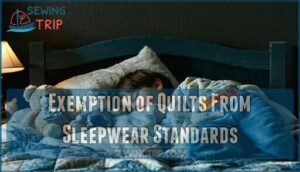This site is supported by our readers. We may earn a commission, at no cost to you, if you purchase through links.

These fabrics ignite too quickly or won’t self-extinguish when exposed to small flames, putting kids at serious risk of burn injuries.
The Flammable Fabrics Act mandates strict flame resistance standards for all children’s sleepwear in sizes 0-14.
Fabrics that can’t pass these tests must carry warning labels – it’s not just legal fine print, it’s your safety net.
A loose cotton flannel that seems harmless could turn a minor kitchen accident into a life-threatening situation.
You’ve got two safe alternatives: flame-retardant treated fabrics that resist ignition, or snug-fitting designs that minimize air flow and reduce fire contact with skin.
Understanding these regulations helps you make smarter choices, but there’s more to think about regarding fabric composition and washing effects.
Table Of Contents
Key Takeaways
- You’ll find "do not use for children’s sleepwear" on fabrics that failed federal flammability tests – these materials ignite too quickly or won’t self-extinguish, creating serious burn risks for kids.
- The Consumer Product Safety Commission requires all children’s sleepwear (sizes 0-14) to meet strict flame resistance standards under the Flammable Fabrics Act – it’s not optional safety advice, it’s federal law.
- You can safely use these warning-labeled fabrics for quilts since they’re classified as bedding, not clothing, and don’t come into direct contact with your child’s body during sleep.
- When choosing sleepwear, you’ll need either flame-retardant treated fabrics or snug-fitting designs that minimize air flow – avoid untreated cotton flannel and synthetic materials that can melt and stick to skin.
Understanding Fabric Warnings for Children’s Sleepwear
When you see fabric labeled "do not use for children’s sleepwear," it means the material hasn’t passed strict federal flammability tests required by the Consumer Product Safety Commission.
These warnings protect kids from serious burn injuries by ensuring only flame-resistant or snug-fitting fabrics are used for pajamas and nightgowns.
Flammability Regulations and Safety Standards for Children’s Sleepwear
Federal CPSC standards under the Flammable Fabrics Act require children’s sleepwear (sizes 0-14) to meet strict testing requirements for flame resistance.
These childrens sleepwear safety regulations protect kids from burn injuries through compliance penalties and labeling mandates.
When you see "not intended for children’s sleepwear" warnings, it means the fabric failed flammability regulations.
Child safety standards demand either flame retardant treatment or snug-fitting designs.
Understanding these flame retardant rules helps you make safer choices for your little one’s nighttime comfort.
Importance of Flame Retardant or Form-fitting Sleepwear for Children
Protecting your child starts with smart sleepwear choices that meet rigorous CPSC recommendations and child safety standards.
Here’s why flame retardant or snug-fitting pajamas matter:
- Burn Injury Reduction – Proper sleepwear cuts emergency room visits by nearly 300 cases annually
- Snug Fit Benefits – Tight garments have less air underneath, reducing fire contact risk
- Flame Resistance Explained – Treated fabrics self-extinguish when removed from flames
- Safe Sleepwear Choices – Compliant options protect against small flame exposure
- Sleepwear Safety Standards – Regulations guarantee children’s sleepwear safety through strict testing
Smart sleepwear regulations exist because kids often play with fire near bedtime, making proper protection essential.
Prioritize garments made with hypoallergenic materials for sensitive skin.
Exemption of Quilts From Sleepwear Standards
You’ll find quilts exempt from children’s sleepwear flammability standards because they serve a different purpose than clothing.
Unlike pajamas that fit close to the body, quilts aren’t expected to come into direct contact with open flames during normal use, which makes them exempt from certain regulations.
Different Safety Requirements for Quilts Compared to Sleepwear
Quilts operate under different safety rules than children’s sleepwear because of their intended use and construction.
Federal regulations don’t apply sleepwear flammability standards to quilts since they’re classified as bedding, not wearing apparel.
Quilt construction involves layered design and material thickness that differs from clothing. Size differences and how quilts drape also matter—they’re less likely to catch fire than loose pajamas.
Safety standards recognize that quilts serve a different purpose than garments worn against skin during sleep. These standards were developed in response to the Flammable Fabrics Act.
Quilts Not Expected to Come in Close Contact With Open Flames
Unlike children’s pajamas that brush against skin during sleep, quilts maintain distance from your child’s body during use.
This quilt proximity creates a natural safety buffer against potential flame exposure.
Regulators recognize that quilt materials serve different purposes than kids sleepwear safety requirements.
You won’t find fabric safety warnings on quilting cotton because intended use differs substantially from clothing.
Thermal hazards remain minimal when quilts stay positioned away from heat sources.
Even without flame resistant materials or flame retardant chemicals, quilting fabrics pose lower risks than loose sleepwear that could catch fire easily.
Safety Standards Specific to Sleepwear for Children
Children’s sleepwear safety standards exist for good reason – they’re designed with child protection in mind.
The Consumer Product Safety Commission requires strict fabric testing to guarantee flame resistance and burn prevention.
These childrens sleepwear safety standards mandate that garments either fit snugly or contain flame resistant materials to pass fabric flammability standards.
When you see "not for children’s sleepwear" labels, it means the fabric failed these tests.
However, these childrens clothing safety regulations don’t apply to quilts since they’re bedding, not clothing.
Your quilt won’t be worn close to the body where sleepwear safety guidelines matter most, making flannel perfectly safe for quilting projects.
Parents should prioritize safe fabric choices when selecting materials for their children’s clothing, and can find more information at safe fabric choices.
Using Flannel in Quilts
You’ll find flannel fabric commonly used in quilting projects, even though it carries the "not for children’s sleepwear" warning required by federal regulations.
Quilts made with flannel don’t pose the same safety risks as loose-fitting sleepwear since they’re not worn directly on the body during sleep, and this is due to the nature of the quilt itself being a quilting project.
Common Practice of Using Flannel in Quilt Projects
You’ll find flannel fabric choices dominating many quilting projects due to their soft texture and cozy warmth.
This popular quilt material offers exceptional comfort for children’s bedding without triggering sleepwear fabric guidelines. Flannel safety concerns that apply to children’s clothing safety don’t extend to quilting techniques, since quilts aren’t classified under flammability regulations for sleepwear.
The use of high-quality flannel quilt fabric is essential for a durable and cozy quilt.
Consider these flannel benefits for your next project:
- Comfort factor – Creates that snuggly feeling kids crave during bedtime stories
- Durability advantage – Withstands countless washes while maintaining softness
- Design flexibility – Works beautifully with various sewing tips and fabric safety warnings don’t restrict quilt use
Quilts Made With Flannel Do Not Pose a Safety Risk
When your child snuggles under flannel quilts, you’re not breaking safety rules.
Here’s why flannel safety differs between quilts and children’s sleepwear:
| Category | Quilts | Sleepwear |
|---|---|---|
| Flame Contact Risk | Minimal during sleep | Direct body contact |
| Safety Requirements | No flame retardant needed | Must meet CPSC standards |
| Fabric Safety Warnings | Not applicable | Required labeling |
Quilts don’t require flame resistance because they’re not classified as sleepwear.
Child protection regulations focus on garments touching skin, not bedding materials.
Your flannel quilt materials pose no fabric risks when used properly for bedding.
Understanding the best fabric for quilting projects, including quilting cotton options, can help you make informed decisions about your quilting needs.
Concerns About Flame Retardant Chemicals
While flame retardant chemicals offer protection against fire, they can wash out over time and don’t shield children from smoke inhalation during emergencies.
You’ll also find that certain fabric compositions like polyester can melt and stick to skin when exposed to heat, creating additional safety concerns.
Potential for Flame Retardant Chemicals to Wash Out After Laundering
Over time, flame retardant chemicals can wash out from treated fabrics, reducing their protective effectiveness.
Studies show up to 92% of certain flame retardant chemicals disappear into laundry wastewater during home washing. Harsh detergents, bleach, and high-heat drying accelerate this chemical loss.
Federal regulations require flame resistant fabrics to maintain protection after 20-50 wash cycles, but some fabric treatments don’t meet these durability standards.
That’s why proper laundry safety matters—gentle washing helps preserve flame resistance longer. Understanding flame retardant risks is essential for making informed decisions about fabric choice and care, considering the importance of flame resistance and informed decisions.
Ineffectiveness of Flame Retardant Clothing in Preventing Smoke Inhalation
Flame retardant clothing’s protection has serious limitations you should understand.
While these treatments reduce burn risks, they can’t shield you from toxic fumes during house fires.
Smoke inhalation causes most fire-related deaths, not direct flame contact.
Consider these sobering realities:
- Flame resistant fabrics still allow deadly smoke particles to reach your lungs
- Toxic fumes disable victims within minutes, before fabric safety features matter
- Most residential fire fatalities stem from smoke inhalation, not burns
Flammability regulations focus on preventing ignition, but sleepwear safety tips often overlook this critical gap in protection, related to flame resistant fabrics.
Impact of Fabric Composition, Such as Polyester, on Safety in Sleepwear
Polyester fabric composition creates unique fabric safety challenges in children’s sleepwear.
While polyester offers flame resistance, it melts when heated, potentially sticking to skin and causing severe burns.
This material risk makes polyester less ideal than natural fibers for sleepwear standards.
Flammability regulations recognize these fiber hazards – polyester’s melting properties can worsen injuries despite meeting flame retardant requirements.
Parents should understand that fabric composition affects safety differently than traditional burning.
Children’s sleepwear safety depends on balancing flame resistance with material risks for superior protection, considering the material risks.
Choosing Safe Materials for Children’s Sleepwear
When choosing sleepwear fabrics for your child, you’ll need to understand why some materials carry safety warnings and which ones meet federal flammability standards.
The right fabric choice can mean the difference between a minor incident and a serious burn injury, so it’s worth knowing what makes certain materials safer than others.
Importance of Selecting Fabrics That Meet Safety Standards for Sleepwear
When protecting your child’s safety, fabric choice makes all the difference.
Safety standards exist because they work – they’ve helped reduce sleepwear-related burn injuries by establishing clear guidelines for manufacturers and parents.
Here’s what to look for in safe sleepwear materials:
- CPSC compliance labels – Check for 16 CFR Parts 1615/1616 certification
- Flame retardant treatments – Look for chemically treated fabrics that self-extinguish
- Snug-fitting designs – Tight cotton blends reduce fire exposure risks
- Inherently flame-resistant fibers – Materials like modacrylic offer built-in protection
These fabric safety regulations aren’t just bureaucratic red tape – they’re your shield against fire risks that could harm your child.
Parents should prioritize natural fiber options to guarantee the best protection for their kids.
Avoidance of Polyester and Synthetic Materials That Can Melt and Stick to The Skin
Your child’s safety depends on avoiding synthetic materials that transform into molten hazards when exposed to heat.
Polyester and similar fabrics melt at just 260°C, creating sticky masses that adhere to skin and cause severe burns.
Unlike flame resistant natural fibers, these synthetic dangers pose melting risks that standard flame retardant chemicals can’t prevent.
Choose fabric safety over convenience. When selecting children’s sleepwear, consider the benefits of non synthetic materials to minimize risks.
Consideration of Flammability and Safety When Choosing Materials for Sleepwea
Fabric selection becomes a critical safety decision when you’re shopping for your child’s pajamas.
You’ll want to prioritize flame resistance and sleepwear safety above all else.
Look for materials that pass fabric testing requirements and meet flammability standards set by the CPSC.
Flame retardant treatments substantially reduce burn hazards and enhance child protection.
Avoid fabrics with "not intended for children’s sleepwear" warnings—they’ve failed safety tests.
Cotton blends without treatments pose fabric flammability risks, while synthetic materials can melt.
Smart choices in childrens sleepwear safety protect against sleepwear flammability dangers during those vulnerable nighttime hours.
They ensure a safer environment by considering the flammability standards set by the CPSC and the importance of child protection.
Frequently Asked Questions (FAQs)
What are fabric warnings on children’s sleepwear?
Like a bright red flag waving danger, fabric warnings tell you this material hasn’t passed federal safety tests.
You’ll see "not intended for children’s sleepwear" when fabrics can’t meet strict flammability standards, protecting kids from burn injuries.
What does ‘not intended for children’s sleepwear’ mean?
When you see "not intended for children’s sleepwear" on fabric labels, it means the material fails federal safety tests.
These fabrics burn too quickly or don’t meet strict flammability standards, making them dangerous for kids’ pajamas, as they do not comply with the required safety regulations to prevent dangerous situations.
Is ‘not intended for children’s sleepwear’ legal?
Yes, it’s completely legal. Federal law requires manufacturers to label fabrics that don’t meet strict flammability standards with "not intended for children’s sleepwear." This protects you from buying unsafe materials.
Can you use ‘don’t use for children’s sleepwear’?
You can’t legally use that phrase. Federal law requires the exact wording "not intended for children’s sleepwear" on non-compliant fabrics. Using different language violates CPSC regulations and creates liability.
Is polyester safe for children’s sleepwear?
Polyester can be safe for children’s sleepwear when it’s flame-resistant or snug-fitting. However, untreated polyester melts and sticks to skin when heated, creating serious burn risks that require careful consideration.
Are non coated fabrics safe for children’s sleepwear?
Non-coated fabrics fail federal flammability standards, making them dangerous for children’s sleepwear. You’ll find these fabrics burn quickly and don’t self-extinguish, creating serious burn risks during sleep hours.
What fabrics require not for sleepwear warnings?
Cotton, flannel, silk chiffon, untreated polyester blends, and loose-weave fabrics require warnings because they’re highly flammable and fail CPSC safety tests for children’s sleepwear compliance.
How are sleepwear flammability tests conducted?
Like precision clockwork, technicians conduct vertical flame tests by igniting fabric samples with a controlled flame.
They measure char length and afterglow time, ensuring results don’t exceed 2 inches per second burn rate for compliance.
Do flame retardant treatments affect fabric comfort?
Yes, flame retardant treatments can affect fabric comfort.
They may make materials stiffer, less breathable, or cause skin irritation for some children.
However, modern treatments have improved substantially, offering better comfort while maintaining safety standards and providing a more comfortable experience with modern treatments.
Are there exceptions to childrens sleepwear regulations?
Several exceptions exist in children’s sleepwear regulations.
You can dress kids in snug-fitting cotton pajamas without flame retardants, since tight clothes won’t catch fire easily.
Infants under nine months aren’t covered by these rules either, and this is an important consideration for children’s sleepwear.
Conclusion
Protecting your child starts with understanding why fabric say "do not use for children’s sleepwear" – it’s failed critical flame tests.
These warnings aren’t suggestions; they’re federally mandated safety alerts identifying materials that ignite too quickly or won’t self-extinguish.
When you’re shopping for your child’s pajamas, always check labels and choose flame-retardant treated fabrics or snug-fitting designs that meet CPSC standards.
Your vigilance today prevents tomorrow’s tragedy.













